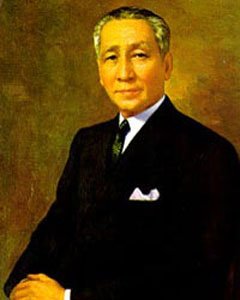 Osmeña, Sergio (1878-1961), Philippine independence leader and statesman, born on Cebu. Trained as a lawyer, he was elected to the first Philippine assembly, became its speaker (1907-1916), and later served as senator from Cebu. Osmeña headed several missions to the United States to argue for Philippine independence and was instrumental in gaining commonwealth status for the Philippines in 1935. Twice elected vice-president of the commonwealth (1935 and 1941), he became president of the government in exile when President Manuel Quezon died in 1944. He was, however, defeated (1946) in the first elections of an independent Philippines.
Osmeña, Sergio (1878-1961), Philippine independence leader and statesman, born on Cebu. Trained as a lawyer, he was elected to the first Philippine assembly, became its speaker (1907-1916), and later served as senator from Cebu. Osmeña headed several missions to the United States to argue for Philippine independence and was instrumental in gaining commonwealth status for the Philippines in 1935. Twice elected vice-president of the commonwealth (1935 and 1941), he became president of the government in exile when President Manuel Quezon died in 1944. He was, however, defeated (1946) in the first elections of an independent Philippines. He was the founder of the Nationalist Party (Partido Nacionalista) and president of the Philippines from 1944 to 1946. Osmeña received a law degree from the University of Santo Tomás, Manila, in 1903. He was also editor of a Spanish newspaper, El Nuevo Día, in Cebu City. In 1904 the U.S. colonial administration appointed him governor of the province of Cebu and fiscal (district attorney) for the provinces of Cebu and Negros Oriental. Two years later he was elected governor of Cebu. In 1907 he was elected delegate to the Philippine National Assembly and founded the Nationalist Party, which came to dominate Philippine political life.
Osmeña remained leader of the Nationalists until 1921, when he was succeeded by Manuel Quezon, who had joined him in a coalition. Made speaker of the House of Representatives in 1916, he served until his election to the Senate in 1923. In 1933 he went to Washington, D.C., to secure passage of the Hare-Hawes-Cutting independence bill, but Quezon differed with Osmeña over the bill's provision to retain U.S. military bases after independence. The bill, vetoed by the Philippine Assembly, was superseded by the Tydings-McDuffie Act of March 1934, making the Philippines a commonwealth with a large measure of independence. The following year Osmeña became vice president, with Quezon as president. He remained vice president during the Japanese occupation, when the government was in exile in Washington, D.C. On the death of Quezon in August 1944, Osmeña became president. He served as president until the elections of April 1946, when he was defeated by Manuel Roxas, who became the first president of the independent Republic of the Philippines.
No comments:
Post a Comment